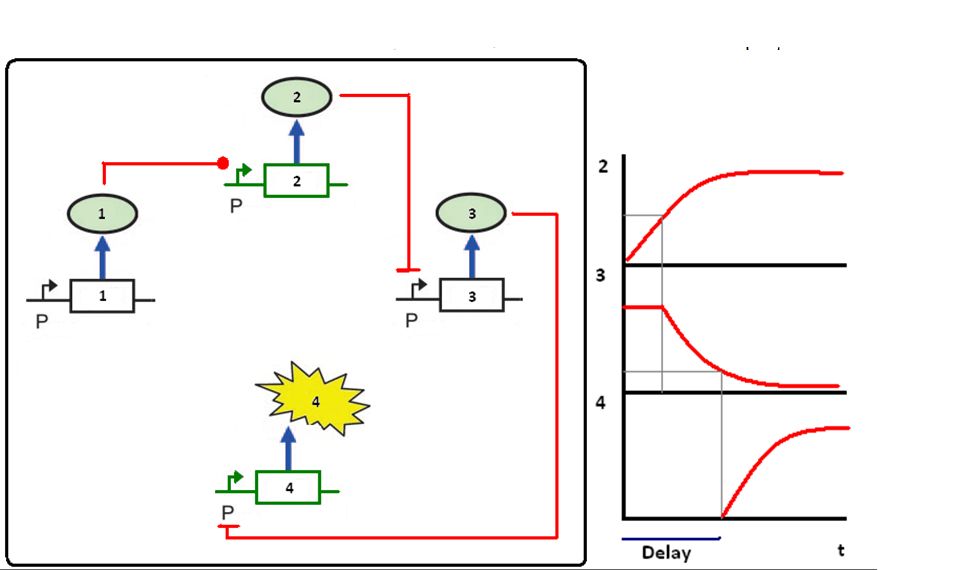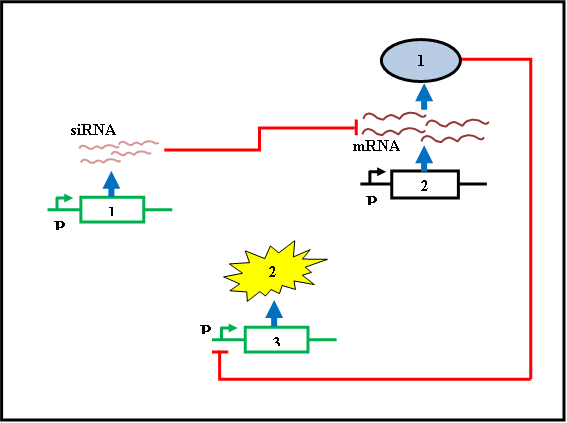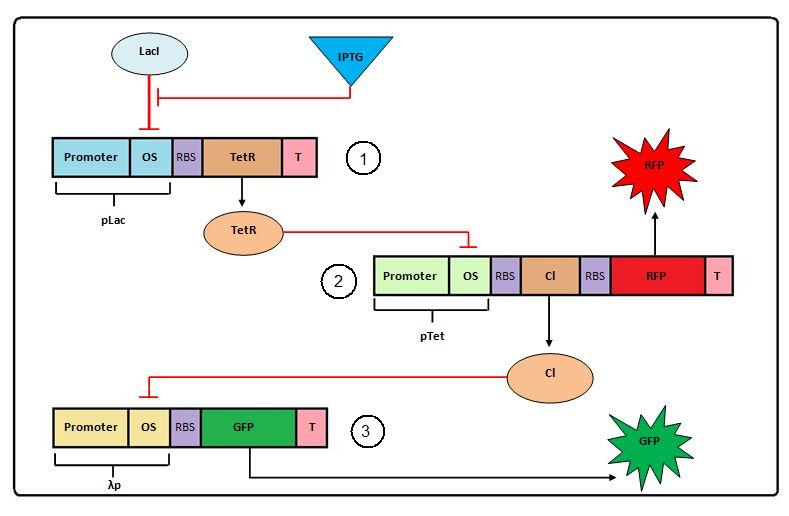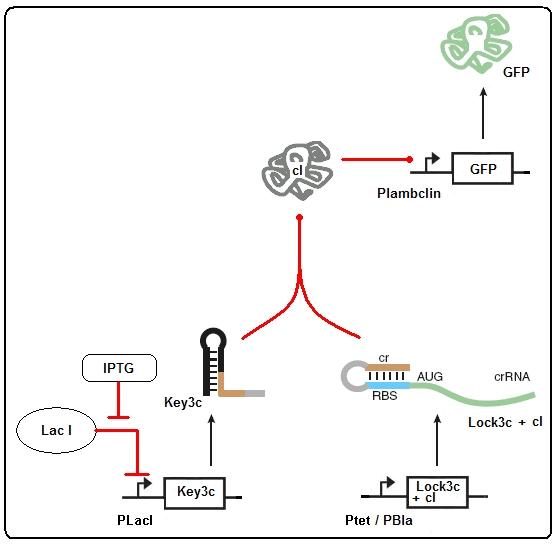Team:TUDelft/Research Proposal
From 2009.igem.org
| Line 116: | Line 116: | ||
</table><br> | </table><br> | ||
| - | |||
| - | |||
| - | |||
| - | |||
| - | |||
| - | |||
| - | |||
| - | |||
| - | |||
| - | |||
| - | |||
| - | |||
| - | |||
| - | |||
| - | |||
| - | |||
| - | |||
| - | |||
| - | |||
| - | |||
| - | |||
| - | |||
| - | |||
| - | |||
| - | |||
| - | |||
| - | |||
| - | |||
| - | |||
| - | |||
| - | |||
| - | |||
| - | |||
| - | |||
| - | |||
| - | |||
| - | |||
| - | |||
{{Template:TUDelftiGEM2009_end}} | {{Template:TUDelftiGEM2009_end}} | ||
Revision as of 10:27, 7 October 2009
Research Proposal
Contents |
Module 1: Delay device
Delayed expression genetic circuit: This kind of circuit has the ability to integrate signals and trigger events after a delay from the initial detection event. There are two approaches to construct a time delay genetic circuit, these are:
- “protein-based” transcriptional regulators
- “RNA-based” posttranscriptional regulators[1]
Based on different literature, we had four different configurations for the time delay genetic circuit. Of the four approaches, two are protein-based and other two are RNA-based.
Positive Cascade
Based on the book of Uri Alon[2] and the project requirements, the next scheme can be proposed:Figure 1: Genes 1 and 3 are present in the cell and they are produced all the time (black). Genes 2 and 4 (green) are in the self destructive plasmid (SDP).
Description
Protein 1 starts the circuit activating the promoter of gene 2, for proof of concept gene 1 can be changed for a signal molecule. The concentration of protein 2 will increase and achieve the threshold concentration to induce gene 3. As the concentration of protein 3 increases, the induction of gene 4 (restriction enzyme or fluorescent protein) starts.
Parameters
In order to make a longer or shorter delay the protein production and degradation rates have to be considered. For the former, we can “play” with the ribosome binding site (RBS) and promoter strength. The degradation can be controlled by protein stability, induction of degradation and up-down regulation of degradation enzymes.
Biobricks
- new RBS
- new transcriptional factors with different stabilities
- new promoters with different strengths
Take into account
- There are many of biobricks like 1 and 3 in the registry
- Positive feed is always related to leaking problems
- Time frame
- Change LVA tag to decrease degradation
Modeling
Differential equations involving production rate, degradation rate (and dilution rate)
Small interfering RNA
This approach is based on the gene silencing by small interfering RNA explained in Elbashir et al.[3] and is given in the following scheme:
Figure 2: Genes 1 and 3 are present in the self destructive plasmid. Gene 2 is present in the cell and is always produced.
Description
Protein 1 is always produced in the cell and is controlled by the constitutive promoter on gene 2. This protein must be selected carefully since the gene 1 producing the siRNA must be decided based on this protein and the siRNA must be specific for silencing the mRNA of protein 1 without disturbing the other mRNAs of the host organism. The protein 1 will be in excess concentration and hence will inhibit the production of protein 2 (restriction enzyme or fluorescence protein) by repressing the promoter of gene 3. When the production of siRNA is induced by activating the promoter of gene 1, on reaching a threshold it will interfere with the translation of protein 1 and hence the repression of gene 3 is released to produce the protein 2.
Parameters and take into account
- Protein 1’s stability
- siRNA specificity
- Promoter strength
Biobricks
- new RBS
- new transcriptional factors with different stabilities
- new promoters with different strengths
- siRNA’s
Modeling
- Differential equations involving production rate, degradation rate (and dilution rate)
- Interaction siRNA’s - mRNA
Disadvantages in the approaches above
In the positive cascade we anticipated that we will encounter the problem of leaky expressions of transcription factors and genes, which may cause drastic effects in an efficient delay system.
For the siRNA approach we could not find literature evidence whether siRNA works in prokaryotes. This causes a major setback in this approach for using it in our host organism E.coli. Because of these disadvantages we felt the other two approaches described as follows in below could be used.
Negative Cascade
Based on Hooshangi et al.[4] and the project requirements, the next scheme can be proposed:Figure 3: Gene constructs 1 and 3 are present in the cell and they are produced all the time. Gene construct 2 is in the self destructive plasmid (SDP). ![]() indicates repression.
indicates repression.
Description
IPTG starts the circuit activating (or repressing the repressor of) the promoter of TetR, for proof of concept we have used a signal molecule. The concentration of protein TetR will increase and achieve the threshold concentration to repress gene cI. At this point the production of protein cI stops. As the concentration of protein cI decreases due to its degradation, the repression of GFP gene will no longer exist and the production of GFP starts. In the final circuit it will be replaced by the restriction enzyme gene.
Parameters
In order to make a longer or shorter delay the protein production and degradation rates have to be considered. For the former, we can “play” with the ribosome binding site (RBS) and promoter strength. The degradation can be controlled by protein stability, induction of degradation and up-down regulation of degradation enzymes.
Biobricks
- new RBS
- new transcriptional factors with different stabilities
- new promoters with different strengths
Take into account
- Time frame
- Change LVA tag to decrease degradation
Modeling
Differential equations involving production rate, degradation rate (and dilution rate)
Riboregulator
In bacteria, several factors affect translation initiation, including ribosomal recognition of the mRNA’s RBS and the start codon (AUG). Recognizing the importance of RNA interactions between the ribosome and RBS, and based on work on endogenous riboregulators, Isaacs et al.[5] sought to regulate bacterial gene expression by interfering with ribosomal docking at the RBS. From the outset, their objective was to create a modular post transcriptional regulation system that could be integrated into biological networks and implemented with any promoter or gene. This system was already used by Friedland et al.[6].
Figure 4: taRNA/RBS (riboregulator) regulated expression of GFP or Restriction endonuclease. Genes key3c, lock3c and cl are on the conjugative plasmid present in all cells. IPTG: signal molecule. GFP/Restriction endonuclease gene is present on the SDP. RBS: ribosome binding site. cr: piece of RNA strand in front of RBS that is complementary to RBS. Key3c is taRNA (trans-activating RNA), could also be small interference RNA, as long as it is complementary to cr. Product could be either GFP/luciferase (for testing) or endonuclease.
Description
Gene cl is constitutively expressed with lock3c using promoter pTet or pBla while the key3c is inducible by signal molecule IPTG (repressing the repressor LacI) using promoter pLacI. Gene cl is expressed constitutively with the crRNA, lock3c on which the cr part of the RNA binds the RBS directly after transcription, causing RBS to be blocked for the ribosome and therefore blocks the RNA from translation. When pLacI is induced by IPTG, it produces the taRNA molecule, key3c which is complementary to the cr part of the lock3c. When the key3c binds the lock3c it opens the RBS, which makes the crRNA ready for translation. The resulting product (the grey colored folded protein in figure 4) can then induce the gene to produce end-product which may be GFP or endonuclease.
Parameters and take into account
- taRNA (key3c) should be better complementary to cr (lock3c) than cr to RBS, to make sure that taRNA causes the RBS to open up
- One can play with promoter strengths for genes of key3c and end product
- The degradation rate of cl (the grey colored folded protein in figure 4) can influence the delay time
- Instead of cI inducing end-product expression, it might repress a repressor of a promoter (negative cascade, see figure 3), to get rid of leaky expression
- Take into account “scars”
- Time frame
Biobricks
- new RBS
- new transcriptional factors with different stabilities
- new promoters with different strengths
- crRNA for each RBS in the registry
- taRNA for each crRNA
Modeling
- Differential equations involving production rate, degradation rate (and dilution rate)
- Interaction crRNA’s – RBS and crRNA’s – taRNA’s
- Stability of taRNA’s
Combination of these approaches
These negative cascade and riboregulator approaches may also be combined if a large delay time is required.
Which biobricks we could use
| Part | Biobrick | Well | Plate | Plasmid | >Antibiotic | >Size (bp) |
|---|---|---|---|---|---|---|
| pLac/PLacI | R0010 | 1D | 1 | pSB1A2 | Amp | 200 |
| PBla | I14018 | 18N | 1 | pSB2K3 | Kan | 35 |
| Plambclin | I12006 | 11J | 2 | pSB2K3 | Kan | 82 |
| pTet/Ptet | R0040 | 6I | 1 | pSB1A2 | Amp | 54 |
| key3c | J23008 | 3F | 1 | J23006 | Amp | 94 |
| Lock3c | J23031 | 3L | 1 | J23006 | Amp | 42 |
| GFP | E0040 | 14K | 1 | pSB1A2 | Amp | 720 |
| mRFP1 | E1010 | 18F | 1 | pSB2K3 | Kan | 681 |
| cI | C0051 | 4E | 1 | pSB1A2 | Amp | 750 |
| RBS | B0034 | 2M | 1 | pSB1A2 | Amp | 12 |
| T (Double Terminator) | B0015 | 23L | 1 | pSB1AK3 | Amp/Kan | 127 |
| λp-RBS-GFP-T | S03335 | 85 | Box9 | pSB1A2 | Amp | 932 |
| λp-RBS-mRFP1-T | S03473 | 79 | Box9 | pSB1A2 | Amp | 918 |
| RBS - cI - RBS | K081013 | 12D | 2 | pSB1A2 | Amp | 819 |
| TetR | C0040 | 4A | 1 | pSB1A2 | Amp | 660 |
 "
"











